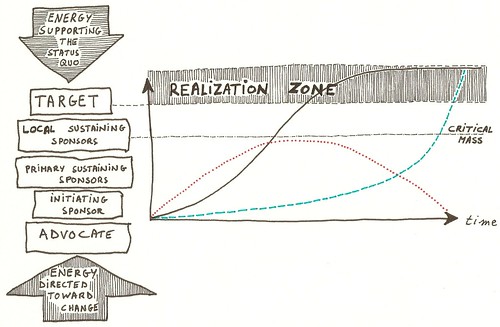Social Architecture is an upgrade for Change Management as we know it. Does this mean that Change Management is bugged? Well… sort of…
In this article I present an overview of the things in change management I believe in. At the end of this article I try to connect the dots with Social Architecture. My conclusion is that Social Architecture is an upgrade, not a replacement.
The Four Containers
The organizational change management approach caters for 4 different elements. They are: Communication, Learning, Organization and Performance. Each element represents a specific need that people have during a change.
- Communication: people need an identity to hang onto so they can see what is in it for them. Constructing an identity for your project is necessary in order to provide an answer to the question “What’s In It For Me?”.
- Learning: People need to know what is expected of them in terms of attitude, knowledge and skills. A part of this is provided in the form of classroom-trainings (the know-how), but the largest part of the knowledge transfer will take place in practice, during the testing phase and the phase of problem-solving. That is why the learning work is never restricted to the classroom and – most of all – we need to carefully build a network of local ambassadors for the project.
- Organization: this is the need to know “Who does what?”. This means that the setup of the future roles and responsibilities needs to be clarified upfront. Next, the support structure in the long run needs to be setup, i.e.: the community of ambassadors who will be responsible for the sustainability of the solution.
- Performance: Finally, people need to know what exactly will change in practice and how this will affect their working habits and usage of time. This includes a detailed follow-up of the chronology of tasks and the creation of a uniform procedure that is shared among all departments.
Critical Mass
The four elements above determine the scope of change management. However the key success factor for these elements to work is determined by the critical mass that we will be able to create.
The critical mass of a project is a combination of different project roles who are working together to create enough energy to make the change happen. Daryl Conner masters this subject very well. According to Conner, the different roles are:
- Advocate: An advocate is an individual (or group) who wants to achieve a change, but doesn’t have the authority to make it happen.
- Initiating sponsor: The initiating sponsor has the sanctioning power to drive the change process through to realization. He or she has ultimate control of the resources—including human, economic, political, and logistical—required for implementation of the initiative.
- Primary sustaining sponsor: report to the initiating sponsor. They formally sanction the change within their areas of responsibility. Primary sustaining sponsors provide a “united front” of leadership support for the endeavor and coordinate implementation activities across functional or geographical lines as necessary.
- Local sustaining sponsor: Local sustaining sponsors are the individuals or groups who cascade the change below the level of primary sustaining sponsors.
- Agents: An agent is an individual responsible for facilitating the implementation of a change project.
- Targets: Targets are the individuals or groups that must change for realization to be achieved.
Momentum
The main preoccupation of change management is to make sure that the above cascade of critical mass is capable of achieving a momentum in the organization.
In a recent article Conner explained that in order to achieve momentum the sponsors and agents of this project need to find a proper way to manage the pushbacks that arise from risk-factors of this project.
This is what this comes down to visually:

- The solid line shows a change in which momentum meets little pushback from the risk factors and moves quickly to realization.
- The broken line shows an initiative that faced some significant risk factor counterforce and slowly but steadily overcame the organization’s tendency to maintain the status quo.
- The dotted line shows a project in which momentum made some headway at the beginning of its implementation but then became overwhelmed by the counterforces before critical mass was reached with the local sustaining sponsors.
Social Architecture
Finally, the main question to ask before we start this project is ‘what will be left when the project is over?’. This does not refer to the deliverables, but rather to the structure of agents that is put in place to sustain the benefits of this project.
Here is what I have written about Social Architecture earlier:
The objective is to put in place an architecture of people who are bridging the communication gaps that your project is trying to solve. Moreover, this structure should be reinforced by the sponsors to operate in the long run.
Connecting the Dots
For several weeks I have been saying that Social Architecture does not replace Change Management. Rather it is an upgrade. The only question is: how do they relate? Have a look at the attempt below:

Makes sense? Please let me know – because connecting the dots will always be work in progress!



Pingback: Tweets that mention Connecting Some Dots | Reply-MC -- Topsy.com()